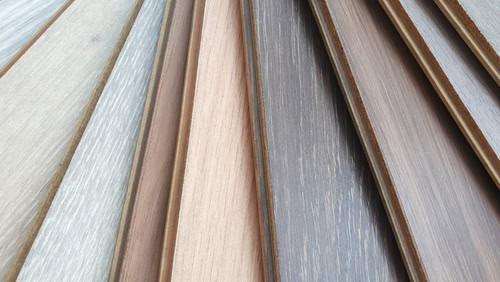
Best Practices for Different Types of Flooring
Best Practices for Different Types of Flooring. Proper floor care is essential for maintaining the beauty and longevity of your flooring.
Floors are one of the most heavily trafficked areas in any home or business, and their condition can significantly impact the overall appearance and feel of a space.
Each type of flooring requires specific care techniques to ensure it stays in the best possible condition.
This article covers best practices for various types of flooring, including hardwood, tile, laminate, and vinyl, and offers detailed advice on how to maintain and protect these surfaces.
Read on – Best Practices for Different Types of Flooring.
Types of Flooring
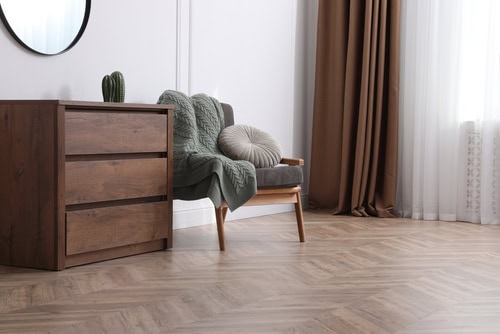
Hardwood
Hardwood floors are known for their natural beauty, durability, and timeless appeal.
Commonly used in both residential and commercial settings, hardwood comes in a variety of species, including oak, maple, cherry, and walnut.
Each type has its unique characteristics, such as grain patterns and color variations, making hardwood a versatile choice.
Hardwood floors can last for decades if properly maintained, but they are susceptible to scratches, moisture damage, and changes in humidity.
Tiles
Tiles are a popular choice for both indoor and outdoor flooring due to their durability and variety.
Ceramic and porcelain are the most common types of tiles used in flooring.
Ceramic tiles are made from natural clay and are typically glazed, which gives them a protective coating.
Porcelain tiles are denser and more resistant to moisture, making them suitable for high-traffic areas and wet environments like bathrooms and kitchens.
Both types of tiles come in a wide range of colors, patterns, and finishes.
Laminate
Laminate flooring is a cost-effective alternative to hardwood, offering a similar appearance without the high price tag.
It is made from a composite material that includes a photographic layer that mimics the look of wood, stone, or other natural materials.
Laminate is known for its easy installation, durability, and resistance to scratches and stains.
However, it is not as moisture-resistant as other flooring options, which can lead to swelling or warping if exposed to water.
Vinyl
Vinyl flooring is prized for its versatility, affordability, and low maintenance requirements.
It comes in various forms, including sheets, tiles, and planks, and can mimic the appearance of hardwood, stone, or ceramic tiles.
Vinyl is highly resistant to water, making it an excellent choice for kitchens, bathrooms, and basements. It is also soft underfoot and provides good sound insulation.
General Maintenance Tips
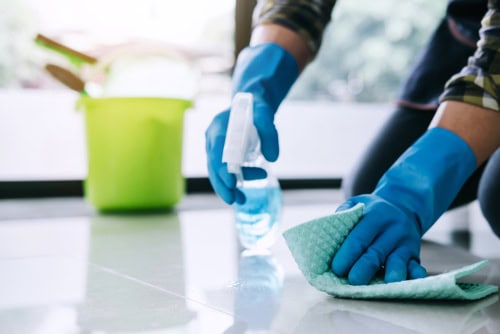
Regardless of the type of flooring you have, certain general maintenance practices can help keep your floors looking their best:
- Regular Cleaning: Sweep or vacuum floors daily to remove dust and debris that can scratch the surface.
- Immediate Spill Cleanup: Clean up spills as soon as they occur to prevent staining and water damage.
- Use Door Mats: Place mats at entrances to reduce the amount of dirt and moisture tracked into the house.
- Furniture Pads: Use pads under furniture legs to prevent scratches and dents.
Regular cleaning and preventive measures are crucial for maintaining the appearance and longevity of all flooring types.
Specific Care Strategies
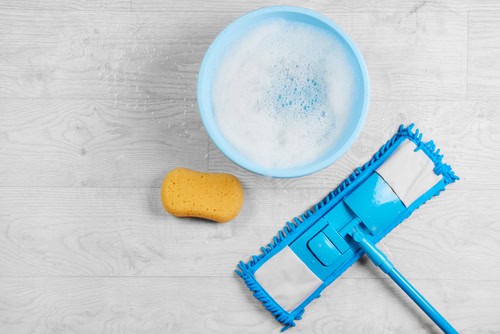
Hardwood Floors
Routine Cleaning Practices
Hardwood floors should be swept or vacuumed daily to remove dirt and debris that can cause scratches.
Use a damp mop with a hardwood floor cleaner to clean the surface, but avoid using excessive water, as it can damage the wood.
It’s essential to use cleaning products specifically designed for hardwood to prevent damage to the finish.
Periodic Deep Cleaning and Refinishing
Periodically, hardwood floors may require deep cleaning to remove built-up grime. This can be done with a hardwood floor cleaner and a soft brush.
Additionally, refinishing hardwood floors every few years can restore their original shine and protect the wood from wear and tear.
This process involves sanding down the surface and applying a new coat of finish.
Tile Floors
Effective Cleaning Solutions and Methods
For tile floors, regular sweeping or vacuuming is essential to remove dirt and prevent scratches. Use a pH-neutral cleaner and a mop to clean the tiles.
For grout lines, use a brush and a mixture of baking soda and water to remove stains and buildup.
Sealant Applications
Applying a sealant to tile floors, especially those with porous surfaces like natural stone, can help protect against stains and moisture.
Sealants should be reapplied periodically, depending on the manufacturer’s recommendations.
Laminate Floors
Preventing Water Damage and Scratches
To protect laminate floors, it’s important to avoid excessive water during cleaning. Use a dry mop or a damp mop with a laminate floor cleaner.
Place mats in areas prone to moisture, such as near sinks, and use furniture pads to prevent scratches.
Recommended Cleaning Products and Tools
Choose cleaning products specifically designed for laminate floors. Avoid abrasive cleaners, waxes, and polishes, as they can damage the surface.
A microfiber mop is ideal for cleaning laminate floors, as it is gentle yet effective at picking up dirt and debris.
Vinyl Floors
Best Practices for Cleaning and Maintaining Shine
Vinyl floors are relatively low maintenance. Sweep or vacuum regularly to remove dirt and debris.
Clean with a vinyl floor cleaner and a damp mop. Avoid using abrasive cleaners or scrubbing pads, as they can dull the finish.
To maintain shine, consider using a polish specifically designed for vinyl floors.
Addressing Stains and Discoloration
For tough stains on vinyl floors, use a mixture of baking soda and water to create a paste, then gently scrub the stain with a soft brush.
For more stubborn stains, a vinyl floor cleaner can be used. Always test cleaning solutions on an inconspicuous area first to ensure they do not damage the floor.
Common Flooring Challenges and Solutions
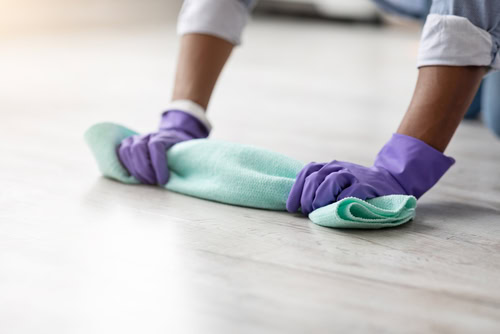
Stain Removal
Techniques for Removing Common Types of Stains
Each type of flooring requires specific techniques for stain removal:
- Hardwood: Use a hardwood floor cleaner or a mixture of vinegar and water. Avoid harsh chemicals that can damage the finish.
- Tile: For grout stains, use a mixture of baking soda and water. For tile stains, a pH-neutral cleaner is best.
- Laminate: Use a laminate floor cleaner and a damp cloth. Avoid excessive water.
- Vinyl: Use a vinyl floor cleaner or a mixture of baking soda and water for tough stains.
Scratch and Damage Prevention
Tips for Furniture Placement and Protective Measures
To prevent scratches and damage to floors, consider the following tips:
- Furniture Pads: Use pads under furniture legs to prevent scratches.
- Area Rugs: Place rugs in high-traffic areas to protect the floor.
- Rearrange Furniture: Periodically move furniture to prevent uneven wear.
Longevity and Aesthetic Maintenance
Regular maintenance, such as sweeping, mopping, and promptly addressing spills and stains, can significantly extend the life of your flooring.
Proper care helps maintain the floor’s appearance and structural integrity, ensuring it remains beautiful and functional for years to come.
Well-maintained floors can enhance the overall appearance of a property, making it more attractive to potential buyers or tenants.
Investing in regular floor care can increase the property’s value and appeal.
Cleaning Products and Equipment
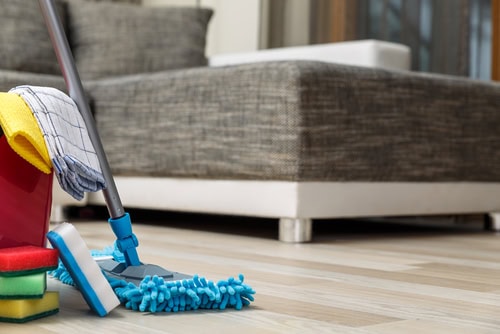
Choosing the Right Cleaning Products
When selecting cleaning products for your floors, consider the following criteria:
- Flooring Type: Use products specifically designed for your type of flooring.
- pH Balance: Choose pH-neutral cleaners to avoid damaging the floor’s finish.
- Eco-friendly Options: Consider eco-friendly and chemical-free products for a safer and more environmentally friendly cleaning solution.
Equipment and Tools
Essential Tools for Effective Floor Care
Having the right tools can make floor care more effective and efficient. Essential tools include:
- Broom and Dustpan: For daily sweeping.
- Vacuum Cleaner: With attachments for different flooring types.
- Microfiber Mop: For gentle and effective cleaning.
- Soft-bristle Brush: For cleaning grout and tough stains.
For deep cleaning, consider investing in specialized equipment such as:
- Steam Cleaner: Effective for deep cleaning tiles and grout.
- Floor Buffer: For polishing and restoring shine to hardwood and vinyl floors.
Best Practices for Different Types of Flooring – Conclusion
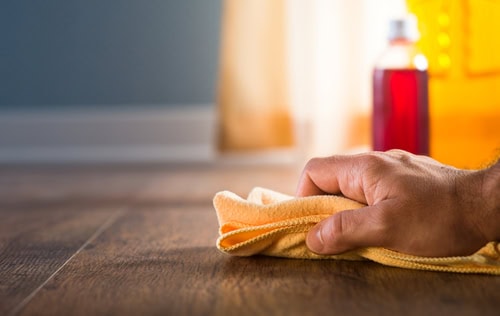
Proper floor care is essential for maintaining the beauty, functionality, and value of your flooring.
Each type of flooring requires specific care techniques, from daily cleaning practices to periodic deep cleaning and refinishing.
By understanding the unique needs of your flooring and using the appropriate cleaning products and tools, you can ensure that your floors remain in excellent condition for years to come.
Regular maintenance not only enhances the appearance of your space but also extends the life of your floors, making it a worthwhile investment.
Incorporate quick daily routines to keep your floors in optimal condition, such as sweeping or vacuuming high-traffic areas and immediately cleaning up spills.
By following these best practices and staying diligent with your floor care routine, you can enjoy beautiful, long-lasting floors that enhance the overall appeal of your home or business!
Are you looking for professional and reliable cleaning services in Singapore? Contact us today!



